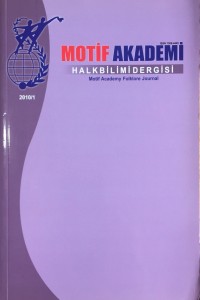Öz
Resources of hami weavings tend to diminish day by day due tochanging /iving comiitions in Aegean Regean today. in given areas in particular, they are exposed ıo a complete disappearnce. Carpets, kilims and plain - weaving textiles have been excluded from research while studying hand-weaving items and the process of change in that they are apt to disappear. Turkish Agean Region consist of eight procinces: lzmir, Manisa, Denizli, Mugla, Aydın, Kütahya, Uşak and Afyon. The hand- weaving items included in apparels and home textiles to be discussed in the circular exist in difef rrent dimensions there in. Handweavings to be debated conlinue to be produced in tradational way in Tire and Odemiş, lzmir ; Yeşilyurt, Mugla; Buldan ami Babadag, Denizli. For instance, in Buldan and Babadag, hand - weavings are both tradational made and produced in automatic and semiautomatic rooms in combination with chancing technology using difef rent textiles materials. Therefore, the region has long been of great importance since antiquıty, which of cource enables hand - weaving to become an industry available to modern conditions. Façhion has recently been observed to influence hues, designs and materials used in today 's textiles. Fashion also determines quantity of purely conventionally- produced items. in the sence ıhaı they increase or decrease accordingly.
Anahtar Kelimeler
Kaynakça
- ACAR, Sedef, (2007). 'Geleneksel Dokuma, Tasarım ve Tanıtım Üçgeninde Kızılcabölük Dokumaları', Uluslar arası Denizli ve Çevresi Tarih ve Kültür Sempozyumu, Denizli,Fakülte Kitabevi Baskı Merkezi.
- ERTEKİN, A.Levent, (2006),Beledi Dokuması, İzmir, Etki Matbaacılık.
- SEZGİN, Şerife, Buldan Dokumaları ve İşlemeleri ', I. Ulusal El Sanatları Sempozyumu,18-2 1 Kasım 1 98 1 , İzmir,Dokuz Eylül Yayınları,İzmir, 1 884.
Öz
Anahtar Kelimeler
Kaynakça
- ACAR, Sedef, (2007). 'Geleneksel Dokuma, Tasarım ve Tanıtım Üçgeninde Kızılcabölük Dokumaları', Uluslar arası Denizli ve Çevresi Tarih ve Kültür Sempozyumu, Denizli,Fakülte Kitabevi Baskı Merkezi.
- ERTEKİN, A.Levent, (2006),Beledi Dokuması, İzmir, Etki Matbaacılık.
- SEZGİN, Şerife, Buldan Dokumaları ve İşlemeleri ', I. Ulusal El Sanatları Sempozyumu,18-2 1 Kasım 1 98 1 , İzmir,Dokuz Eylül Yayınları,İzmir, 1 884.
Ayrıntılar
| Birincil Dil | Türkçe |
|---|---|
| Bölüm | Makaleler |
| Yazarlar | |
| Yayımlanma Tarihi | 1 Haziran 2010 |
| Gönderilme Tarihi | 12 Mayıs 2010 |
| Yayımlandığı Sayı | Yıl 2010 Cilt: 3 Sayı: 5 |



